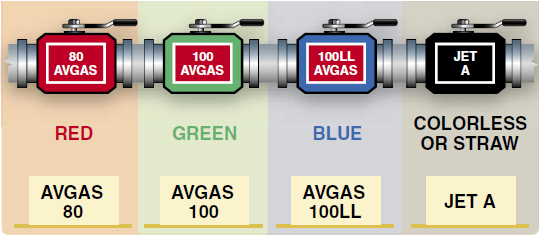AvGas, or “aviation spirit” as it is affectionately referred to in the United Kingdom, is the topic of discussion today. Aviation gasoline (AvGas) is derived from the same principles as motor gasoline found in car engines although with a much higher performance requirement. Why you ask? Well the reason is simple: aircraft engines are typically required to operate in excess of 90% power for extended periods of time (takeoff, climb-out, etc.), while a car engine is typically only operating at around 20-40% power. To increase the octane levels and performance values several additives are added to AvGas the most commonly known of these additives is lead. The addition of lead to gas will allow a piston aircraft engine to operate at a much higher compression due to the resistance against detonation in the engine cylinders. The higher the octane level, the more pressure the fuel can withstand without detonating, creating more power. Using an other-than-specific fuel containing a lower lead content in your aircraft engine will cause pre-mature detonation and a significant decrease in power output. Included in the list of additives to aviation fuels are colored dyes, these dyes are added to assist in differentiating each fuel grade. In addition to the fuel color itself the color coding system noted below extends to aircraft decals and fuel handling equipment located at airports.

The grade of AvGas most commonly used is referred to as 100LL (low lead) and can be found at most airports worldwide. This grade of gas contains anywhere from 1.2-2.0 mL per gallon of lead and is the low lead version of 100/130 grade AvGas which can contain up to 4.0 mL per gallon of lead. It is important to never use a grade of fuel lower then that specified by the aircraft engine manufacturer. If anything, you should choose the next higher grade. It is important to note that “Jet fuel” is NOT a higher-grade version of AvGas – you cannot use Jet Fuel for engines requiring AvGas, nor can you use AvGas for engines requiring Jet Fuel. However, always refer to the aircraft engine manufactures recommendations. Usable fuel grades will typically be listed in the aircraft’s Pilot Operating Handbook or Information Manual.
The FAA knowledge test will contain questions on the subjects of fuel and detonation. To help you prepare, I have included two questions that you are likely to see. For a full sampling of fuel related questions you can refer to our ASA Test Prep Book or Prepware Software for Private Pilot.
1. If the grade of fuel used in an aircraft engine is lower than specified for the engine, it will most likely cause
A—a mixture of the fuel and air that is not uniform in all cylinders.
B—lower cylinder head temperatures.
C—detonation.
2. Detonation occurs in a reciprocating aircraft engine when
A—the spark plugs are fouled or shorted out or the wiring is defective.
B—hot spots in the combustion chamber ignite the fuel/air mixture in advance of normal ignition.
C—the unburned charge in the cylinders explodes instead of burning normally.
Aviation fuel is the only transportation fuel still containing lead. Concerns over lead emissions have caused the industry to seek alternative fuels, for information on the progress and research of alternative aviation fuels visit the FAA web page below.




